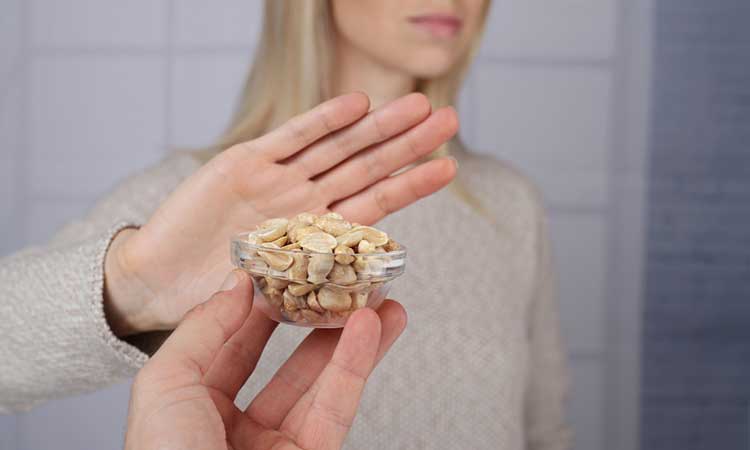

ARE YOU GOING NUTS OVER ALLERGY? TRY HOMOEOPATHY
Peanut Allergy is a type of food allergy where in the person is allergic to peanuts. Though it looks simple it is one of the most dangerous food allergies. An allergy refers to an abnormal exaggerated immune response to a substance, which is termed as the ‘allergen’, in an individual who is allergic towards the specific allergen. Anaphylaxis refers to a severe life-threatening allergic reaction.
Many times peanut allergy is confused with tree nut allergy which is completely different.
Peanuts belong to the legume family and are seen growing underground. Other examples of legumes include beans, peas, lentils and soybeans.
Examples of Tree nuts include –
- Brazil Nuts
- Cashews
- Hazel nuts
- Pecans
- Macadamia Nuts
- Pine Nutrs
- Pistachios
- Walnuts
- Almonds
What Happens To The Body When It Is Exposed To Peanuts?
The immune system provides protection to the body against all the harmful infections affecting it. The substance causing allergy is known as the allergen. Once the body comes in contact with the peanuts (Allergen), the immune system identifies it as foreign. This triggers the cells called as the mast cells to release chemicals that cause many symptoms including dilated blood vessels, low blood pressure, flushing, constricted airways, intestinal problems and even death.
Signs And Symptoms Of Peanut Allergies
Mild to Moderate allergic reaction
- Swelling of lips, face, eyes
- Itchy or runny nose
- Hives or welts
- Tingling mouth
- Abdominal pain, nausea or vomiting
Severe Allergic Reaction (Anaphylaxis)
- Shortness of breath or Difficult Breathing
- Swelling of the tongue
- Swelling /Tightness in throat
- Difficulty talking
- Hoarse voice
- Wheeze or persistent cough
- Dizziness
- Sudden Collapse
- Pale and floppy
- Anxiety, confusion
Diagnosis
It is important to have a proper diagnosis. A thorough and detailed history-taking is very important by the physician as it could be very easily missed if no previous history of any allergies is seen. Often if you have a declared nut allergy you will get your skin tested with a skin prick test or a blood test looking for IgE specific allergy types. Skin testing is important to find out what you are allergic to.
Foods Containing Peanuts
It is very important to avoid the ingestion of peanuts in order to prevent a reaction. Sometimes a casual skin contact could also trigger the allergic reaction.
Some of the products containing Peanuts are:
- Arachis oil ( Also known as Peanut oil)
- Artificial Nuts
- Beer Nuts
- Ground nuts
- Mandelonas (peanuts soaked in Almond flavouring)
- Mixed nuts
- Peanut Butter
- Peanut Flour
- Nut meat
- Nut pieces
- Baked goods ( Cookies, pastries)
- Marzipans ( candy made from nuts, egg whites and sugar)
Treatment
Those who have had a mild allergic reaction to a food substance at one point can have an anaphylactic reaction unpredictably in the future. If you suffer from Peanut Allergy it is advisable to carry an Epinephrine Injection along with you wherever you go as a precaution in an emergency. In case one has an anaphylactic reaction it is important to immediately administer Epinephrine. Additional medication like Antihistamines or Broncho dilators in case of Asthma can be given following the epinephrine.
Homoeopathy For Allergy
The main motive of this beautiful system of medicine in Homoeopathy is to strengthen the immune system and combat any further attacks. Homeopathy does not suppress the allergy symptoms but stimulates the body’s own defence system to cope with the exposure to the allergen. Usually a constitutional medicine is always preferred but one can also take an acute remedy prescribed for symptoms like runny nose, itchy eyes, and so on.
Some of the allergy remedies are:
- Apis Mellifica: The very characteristic effects of the sting of the bee give unerring indications for its use in the disease. There is swelling or puffiness in various parts with stinging pain, soreness and intolerance to the slightest touch.
- Rhus Tox: The effects on the skin and mucus membranes make this a frequently indicated remedy. The eyes appear swollen, red and oedematous. There is a profuse flow of yellow pus. There is constant sneezing. The skin is red and swollen with intense itching.
- Nux Vomica: Gastric symptoms predominate in Nux Vomica. There is a constant urge to pass stools accompanied with cramps in the abdomen. The stools are scanty. Feels unsatisfied. There is nausea, vomiting and loose stools.
- Astacus Flaviatilis: Urticaria is marked. There is a nettle rash all over the body. Itching is present. Swelling of the cervical glands is seen. Mostly liver complaints are accompanied with the rash.
- Sulphur: Burning is a keynote in this remedy. There is marked itching but scratching causes burning. Milk causes aggravation and there is a great desire for sweets.
- Pulsatilla: Complaints come on due to consumption of rich fatty food. The person seeks open air and feels better even though he is cold. Symptoms are ever changing. The mouth is greasy and dry. Thirstlessness is marked in this remedy.
Self Care Measures
- Prevention is better than cure. Avoid foods that contain nuts or its derivatives in any form.
- Make it a norm to check the food labels. Sometimes products you may feel do not contain any nuts may have traces of it.
- Carry a list of foods that you are allergic to everywhere you go in case of emergencies. The Epipen has to be carried wherever you go.
- Make sure your family and friends at work or school know about your food allergies and know whom to contact in case of an emergency.
- Elimination diet: If one is not sure what type of nuts or foods are causing the allergic reaction you may have to do an elimination diet wherein the suspected foods will have to be completely eliminated from the diet and then slowly reintroduced one at a time. This will help link symptoms to intake of specific foods. But if a person has a history of severe life threatening reaction this method is best avoided.
Key Takeaways
- Peanut allergy is a dangerous food allergy that can cause severe reactions, including anaphylaxis.
- Peanuts are legumes, not tree nuts, and can cause symptoms like swelling, hives, and breathing issues.
- Proper diagnosis through history-taking and tests like skin prick or blood tests is crucial to identify peanut allergies.
- Avoiding peanuts and carrying an epinephrine injection are important for managing the allergy and preventing reactions.
- Homeopathy aims to strengthen the immune system, and self-care includes checking food labels and informing others about the allergy.

